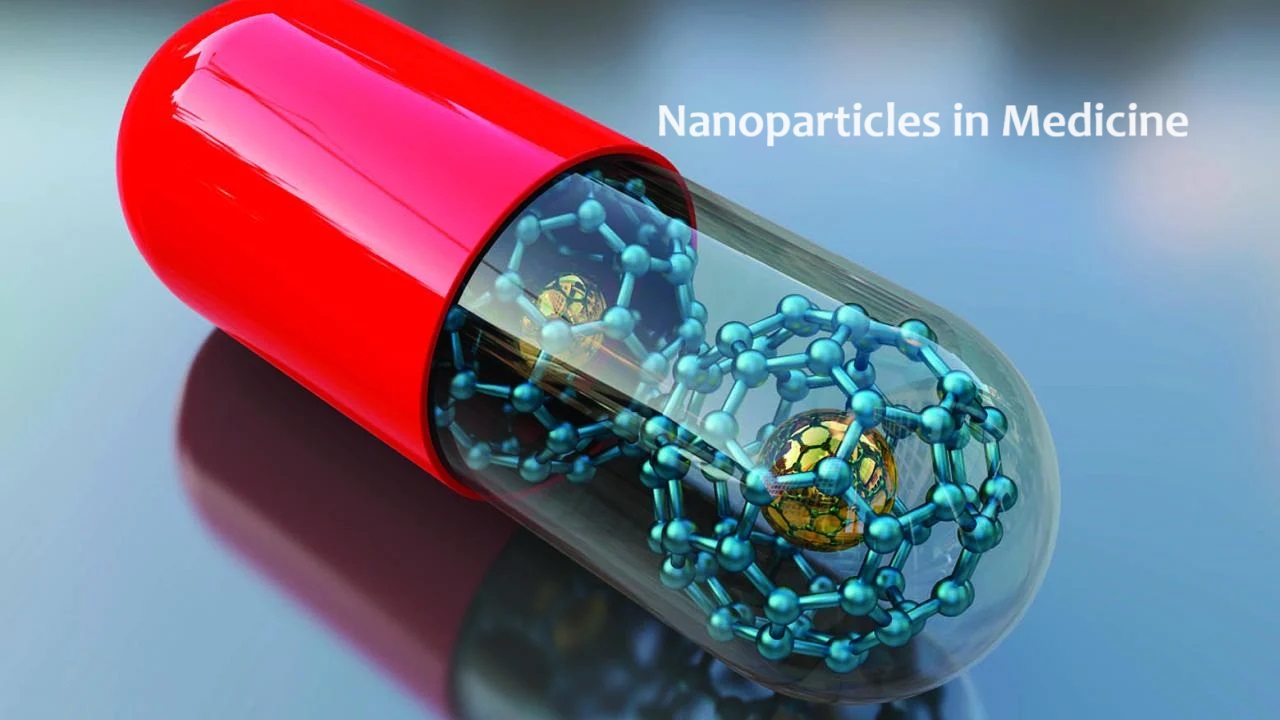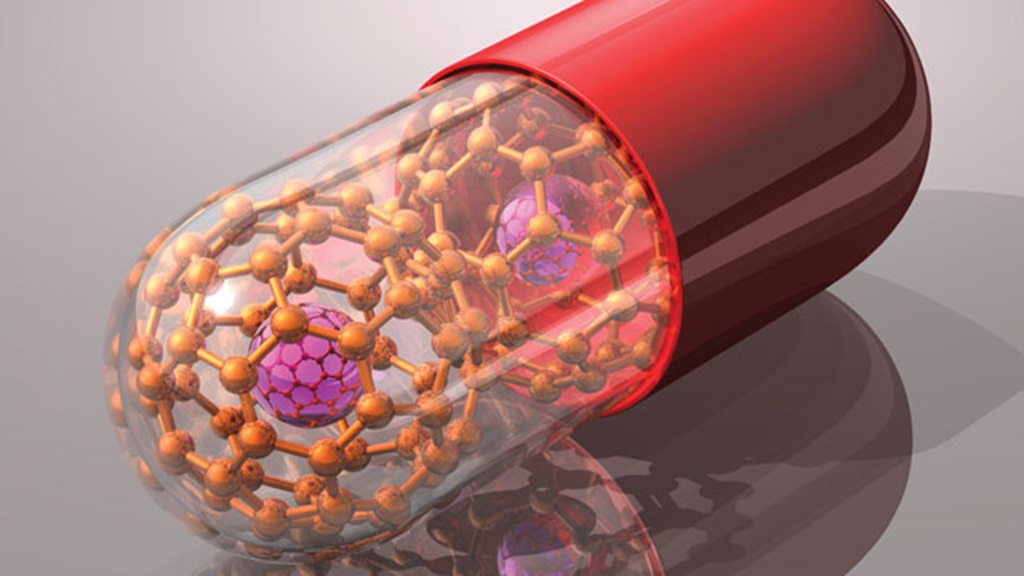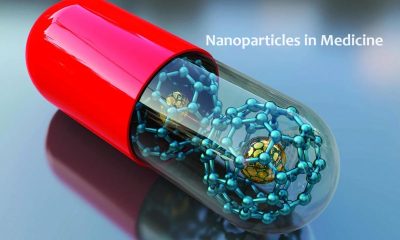Health
The Power Of Particles Unlocking the Power of Nanoparticles in Medicine

In the realm of modern medicine, the integration of nanotechnology has ushered in a new era of innovation and possibility. Nanoparticles, particles with dimensions measured in nanometers, have emerged as powerful tools in various medical applications.
From targeted drug delivery to advanced imaging techniques, these miniature structures hold immense potential to revolutionize healthcare. In this comprehensive exploration, we delve into the types of nanoparticles utilized in medicine, elucidating their advantages and highlighting their role in cutting-edge fields such as nanotechnology eye drops and ophthalmology.

Based on their chemical composition, nanoparticles can be divided into three main groups
Types of Nanoparticles in Medicine:
Liposomes:
Liposomes represent one of the earliest and most extensively studied types of nanoparticles in medicine. Composed of lipid bilayers, liposomes can encapsulate drugs within their aqueous core or lipid membrane. This encapsulation allows for the targeted delivery of therapeutic agents to specific tissues or cells, minimizing systemic side effects. Liposomal formulations have been employed in the treatment of various diseases, including cancer, infectious diseases, and inflammatory disorders.
Polymeric Nanoparticles:
Polymeric nanoparticles are crafted from biocompatible polymers such as poly (lactic-co-glycolic acid) (PLGA) and chitosan. These nanoparticles offer a versatile platform for drug delivery, as their properties can be tailored to meet specific requirements. Polymeric nanoparticles can protect encapsulated drugs from degradation, prolonging their circulation time in the body.
Additionally, they enable controlled release kinetics, allowing for sustained drug release over extended periods. These characteristics make polymeric nanoparticles particularly well-suited for the treatment of chronic conditions and localized therapies.
Metallic Nanoparticles:
Metallic nanoparticles, such as gold and silver nanoparticles, have garnered significant attention in the field of nanomedicine. These nanoparticles exhibit unique optical, electronic, and catalytic properties that can be exploited for therapeutic and diagnostic purposes.
Gold nanoparticles, for instance, have been utilized in cancer therapy through photothermal ablation, where they absorb light energy and convert it into heat to selectively destroy cancer cells. Silver nanoparticles possess antimicrobial properties, making them promising candidates for combating infections and promoting wound healing.
Carbon-Based Nanoparticles:
Carbon-based nanoparticles, including carbon nanotubes and graphene oxide, offer intriguing prospects in medicine owing to their exceptional mechanical, electrical, and thermal properties. Carbon nanotubes, cylindrical structures composed of carbon atoms, have been investigated for their potential in drug delivery, tissue engineering, and biosensing applications. Graphene oxide, a two-dimensional carbon material, exhibits high surface area and biocompatibility, making it suitable for drug delivery systems and biomedical imaging.
Dendrimers:
Dendrimers are highly branched, tree-like molecules with a well-defined structure. These nanostructures can encapsulate drugs within their interior voids or functionalize their surface with targeting ligands for specific delivery to diseased tissues. Dendrimers offer precise control over drug loading and release kinetics, facilitating tailored therapeutic regimens. Moreover, their modular design allows for the incorporation of imaging agents for simultaneous diagnosis and treatment.

Different types of nanoparticles are being used in the medical field.
Advantages of Nanoparticles in Medicine:
The utilization of nanoparticles in medicine offers several distinct advantages over conventional therapeutic approaches:
Targeted Delivery: Nanoparticles can be engineered to selectively target diseased tissues or cells, minimizing off-target effects and enhancing therapeutic efficacy.
Enhanced Bioavailability: Encapsulation of drugs within nanoparticles protects them from degradation and improves their solubility, thereby enhancing their bioavailability and pharmacokinetic profile.
Controlled Release: Nanoparticles enable controlled release of encapsulated drugs, allowing for sustained therapeutic levels over extended periods and reducing the frequency of dosing.
Multifunctionality: Nanoparticles can be functionalized with various moieties, including targeting ligands, imaging agents, and stimuli-responsive triggers, enabling multifunctional platforms for diagnostics and therapeutics.
Reduced Toxicity: Targeted delivery of drugs using nanoparticles can minimize exposure to healthy tissues, thereby reducing systemic toxicity and adverse effects associated with conventional therapies.
Nanotechnology in Ophthalmology:
The application of nanotechnology in ophthalmology has witnessed remarkable strides in recent years, offering novel approaches for the diagnosis and treatment of ocular diseases. Nanoparticles hold immense potential in addressing challenges such as poor ocular bioavailability and the need for sustained drug release in ocular tissues.
Nanotechnology eye drops, for instance, have emerged as a promising strategy for delivering therapeutics to the posterior segment of the eye, bypassing ocular barriers and improving drug penetration. Additionally, nanoparticles-based ocular implants and sustained-release formulations offer prolonged drug release kinetics, enhancing patient compliance and treatment outcomes.
Conclusion:
In conclusion, nanoparticles represent a paradigm shift in modern medicine, offering unprecedented opportunities for targeted drug delivery, diagnostics, and therapeutics. With their diverse range of properties and functionalities, nanoparticles hold immense promise in addressing unmet medical needs and advancing the forefront of healthcare.
From liposomes to metallic nanoparticles and carbon-based nanostructures, the landscape of nanomedicine continues to evolve, ushering in a new era of precision medicine and personalized healthcare. As research in this field progresses, the integration of nanotechnology into clinical practice holds the potential to revolutionize the diagnosis and treatment of various diseases, including those affecting the eyes and vision.
Health
Report Causes Pfizer Stock to Climb Approximately $1 Billion Acquired by Starboard

(VOR News) – According to a rumor that activist investor Pfizer Starboard Value has taken a holding in the struggling pharmaceutical business that is expected to be worth around one billion dollars, the stock of Pfizer (PFE) is on the increase in premarket trading on Monday.
This comes after the report was made public. The report was made available to the general public following this. Starboard Value was successful in moving forward with the acquisition of the position.
Starboard is said to have approached Ian Read, a former chief executive officer of Pfizer, and Frank D’Amelio, a former chief financial officer, in order to seek assistance with its goals of boosting the performance of the company, according to the Wall Street Journal. Read and D’Amelio are both former Pfizer executives.
The purpose of this is to facilitate the accomplishment of its objectives, which include enhancing the overall performance of the firm.
In their previous jobs, D’Amelio and Read were chief financial officers.
It is stated in the report that the hedge fund is of the opinion that Pfizer, which is currently being managed by Albert Bourla, who succeeded Read as Chief Executive Officer (CEO) in 2019, does not demonstrate the same level of mergers and acquisitions (M&A) discipline that Read did. Bourla took over for Read in 2019. Read was succeeded by Bourla in the year 2019.
Pfizer, a multinational pharmaceutical conglomerate, has made substantial investments in the acquisition of more companies that are involved in the research and development of cancer medicines.
These businesses have been acquired for billions of dollars. The biotechnology company Seagen, which was acquired by Pfizer in the previous year for a price of $43 billion, is included in this category. One of the businesses that can be classified as belonging to this category is Seagen.
In spite of the fact that the S&P 500 Index experienced a 21% increase in 2024.
No major trading occurred in Pfizer stock that year.
Due to the fact that the demand for Pfizer’s COVID-19 vaccines fell after the firm reached its pandemic peak in 2021, the share price of the corporation has decreased by over fifty percent since that time.
This drop has occurred ever since the company’s shares reached their maximum peak, which was during the time that this decline occurred. Not only have they not changed at all, but they have also remained essentially stable. This is in contrast to the S&P 500, which has gained 21% since the beginning of this year.
Recently, the corporation was forced to take a hit when it decided to recall all of the sickle cell illness medications that it had distributed all over the world.
Fears that the prescription could lead patients to experience severe agony and possibly even death were the impetus for the decision to recall the product. In spite of the fact that Pfizer’s stock is increasing by almost three percent as a result of the news that followed the company’s decision, this is the circumstance that has come about.
SOURCE: IPN
SEE ALSO:
New Study Reveals Drinking Soda Pop Increases the Risk of Stroke
The Mpox Vaccine’s Protection Decreases Within a Year; Booster Requirements
Health
New Study Reveals Drinking Soda Pop Increases the Risk of Stroke

A recent report from global research indicates that excessive consumption of coffee or soda pop is associated with an increased risk of stroke, although the intake of black and green tea is correlated with a reduced risk. Excessive consumption of soda pop or coffee warrants caution!
Recent research indicates that it may substantially elevate the risk of stroke.
Consuming four cups of coffee daily elevates the risk of stroke, according to studies, although ingesting 3-4 cups of black or green tea daily typically offers protection against stroke. Additionally, consume more coffee; it may reduce your risk of mortality.
Recent findings from global research studies co-led by the University of Galway and McMaster University, alongside an international consortium of stroke researchers, indicate that soda, encompassing both sugar-sweetened and artificially sweetened variants such as diet or zero sugar, is associated with a 22 percent heightened risk of stroke. The risk escalated significantly with the consumption of two or more of these beverages daily.
Stroke Risk Fizzy Drinks and Soda Pop
The correlation between fizzy drinks consumption and stroke risk was most pronounced in Europe, the Middle East, Africa, and South America. Women exhibit the most elevated risk of stroke from bleeding (intracranial hemorrhage) associated with fruit juice beverages. Consuming over 7 cups of water daily diminishes the likelihood of stroke due to a clot.
Researchers observed that numerous items advertised as fruit juice are derived from concentrates and have added sugars and preservatives, potentially negating the advantages often associated with fresh fruit and instead elevating stroke risk.
Fruit juice beverages were associated with a 37 percent heightened risk of stroke resulting from bleeding (intracranial hemorrhage). Consuming two of these beverages daily increases the risk thrice.
Consuming over four cups of coffee daily elevates the risk of stroke by 37 percent, although lower consumption levels do not correlate with stroke risk. Conversely, tea consumption was associated with an 18-20 percent reduction in stroke risk. Additionally, consuming 3-4 cups daily of black tea, such as Breakfast and Earl Grey varieties, excluding green and herbal teas, was associated with a 29 percent reduced risk of stroke.
Consuming 3-4 cups of green tea daily was associated with a 27 percent reduction in stroke risk. Notably, the addition of milk may diminish or inhibit the advantageous effects of antioxidants present in tea. The lower risk of stroke associated with tea consumption was negated for individuals who added milk.
Disclaimer: This article is intended solely for informational reasons and should not be considered a replacement for professional medical counsel. Consistently consult your physician regarding any inquiries pertaining to a medical problem.
Related News:
Starbucks Faces Sales Decline Amid Price Fatigue and Rising Competition
Starbucks Faces Sales Decline Amid Price Fatigue and Rising Competition
Health
Following a Diagnosis of Breast Cancer, What Else Should You Know?

(VOR News) – Even though breast cancer affects one in eight American women, receiving a diagnosis can make a woman feel isolated.
Experts in breast cancer from the American College of Physicians (ACS) advise patients on how to manage their disease so that they may better cope with this awful information.
First, the kind and stage of breast cancer dictates the course of your care.
In addition to immunotherapy and chemotherapy, there are various surgical options available for the treatment of breast cancer.
Women of African descent are disproportionately affected by triple-negative breast cancer, an extremely aggressive form of the disease that has never proven easy to treat.
According to the American Cancer Society, pembrolizumab (Keytruda), an immunotherapy, has been shown to be helpful when combined with chemotherapy and is currently the recommended course of treatment for certain combinations of triple-negative breast cancer.
In her presentation, Dr. Katharine Yao said, “It’s really important that the patient and physician discuss the patient’s preferences and values when deciding what type of treatment to pursue and that they have an honest, individualized discussion with their care team.”
She is currently responsible for developing breast cancer treatment recommendations for more than 575 hospitals and institutions nationwide in her role as chair of the American College of Surgeons’ National Accreditation Program for Breast Institutions (NAPBC).
Yao, vice chair of research at Endeavor Health NorthShore Hospitals in New York, pointed out that each decision made about a patient’s treatment plan should take her preferences and diagnosis into consideration.
She ought to think about whether she would prefer a mastectomy—a surgical procedure that involves removing the entire breast with or without reconstruction—or a lumpectomy, which involves a surgical procedure that spares part of the breast tissue.
She stated that “the breast cancer you have may be very different from the breast cancer you hear about in your neighbor, colleague, or friend” in a press release issued by the American Cancer Society (ACS).
“Consider that while discussing breast cancer with others.”
Throughout your journey, it is critical that you look after your emotional health because having breast cancer may have a detrimental impact on your mental health.
“Getting a cancer diagnosis does not mean that everything in your life stops to be normal.” Director of the Fellowship in the Diseases of the Breast program at the Winthrop P. Rockefeller Cancer Institute at the University of Arkansas and state head of the American Cancer Society Commission on Cancer for Arkansas, Dr. Daniela Ochoa She thinks adding the burden of a cancer diagnosis and treatment to all the other pressures in life may be taxing.
“Managing stress and emotional health is vital component of a treatment plan.”
Ochoa recommends clinically trained psychologists and social workers who have assisted people in coping with cancer to anyone receiving treatment. Learning coping techniques might also be facilitated by joining cancer support groups or cancer wellness initiatives.
Breast cancer specialists say your care team is crucial.
The American Cancer Society (ACS) defines comprehensive care as having support at every stage of the procedure from surgeons, oncologists, patient navigators, nurses, social workers, psychologists, and other specialists.
After receiving a breast cancer diagnosis, women should see a surgeon or medical oncologist to explore their options; nevertheless, treatment shouldn’t be discontinued after just one appointment or after surgery is over.
Additionally, you can ask trustworthy friends or family members to accompany you to appointments and aid you with research or notes. They could serve as a network of support for you.
Yao stated in his talk that “one of the most important things is that patients should search out a team they have confidence in, that they trust will have their back when they need it, and a team they feel they can get access to and that will help them when they are in need.”
SOURCE: MP
SEE ALSO:
The Mpox Vaccine’s Protection Decreases Within a Year; Booster Requirements
COVID was a Paradigm Shift in Health Policymaking, Says Commissioner Stella Kyriakides.
Rwanda Reports 8 Deaths Linked To Ebola-Like Marburg Virus Days After It Declared An Outbreak
-

 News3 years ago
News3 years agoLet’s Know About Ultra High Net Worth Individual
-
Entertainment1 year ago
Mabelle Prior: The Voice of Hope, Resilience, and Diversity Inspiring Generations
-

 Health3 years ago
Health3 years agoHow Much Ivermectin Should You Take?
-

 Tech2 years ago
Tech2 years agoTop Forex Brokers of 2023: Reviews and Analysis for Successful Trading
-

 Lifestyles2 years ago
Lifestyles2 years agoAries Soulmate Signs
-

 Health2 years ago
Health2 years agoCan I Buy Ivermectin Without A Prescription in the USA?
-

 Movies2 years ago
Movies2 years agoWhat Should I Do If Disney Plus Keeps Logging Me Out of TV?
-

 Learning2 years ago
Learning2 years agoVirtual Numbers: What Are They For?


